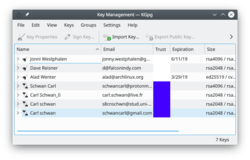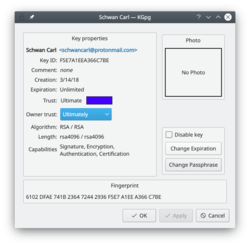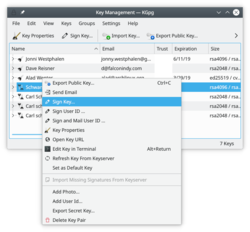KGpg/es: Difference between revisions
(Created page with '{|style="text-align:center" |250px|| ||'''KGpg es una interfaz gráfica para las órdenes de gpg''' |}') |
(Updating to match new version of source page) |
||
| (32 intermediate revisions by 4 users not shown) | |||
| Line 1: | Line 1: | ||
<languages /> | |||
< | __TOC__ | ||
{|style="text-align:center" | {|style="text-align:center" | ||
|[[Image:Kgpg-keymgr.png|250px]]|| ||'''KGpg es una interfaz gráfica para | |[[Image:Kgpg-keymgr.png|250px]]|| ||'''KGpg es una interfaz gráfica para gpg''' | ||
|} | |} | ||
'''GnuPG''' | '''GnuPG''' cifra y descifra tus correos y archivos seleccionados, aunque se necesitan muchas opciones en la línea de órdenes para conseguirlo. Con '''KGpg''' la ansiedad se quita puesto que no tienes que recordar ninguna opción. '''KGpg''' puede ayudarte a configurar y gestionar tus claves, importar y exportar claves, ver las firmas de las claves, estados de confianza y fechas de caducidad. De hecho, prácticamente todo lo que necesitas se puede hacer desde '''KGpg'''. Además dispone de un asistente para ayudarte en la configuración de tus claves. | ||
'''KGpg''' | '''KGpg''' está integrado en [[Special:myLanguage/Konqueror|Konqueror]] y [[Special:myLanguage/Dolphin|Dolphin]], donde un menú contextual te permite cifrar un archivo, tanto firmado con sin firmar. | ||
{| | {| | ||
|[[Image:Kgpg-props.png|thumb|250px| | |[[Image:Kgpg-props.png|thumb|250px|Viendo las propiedades de una clave]]|| ||[[Image:Kgpg-options.png|thumb|250px|Clic con el botón derecho en una clave para ver las opciones]] | ||
|} | |} | ||
== Extending the life of your keys == | |||
|} | As you can see in the image above, you can extend the life of your keys using the <menuchoice>Change Expiration</menuchoice> button. Simply choose the new date from the popup calendar. To do this, however, you must have access to the private key and its pass-phrase. Without them you can do nothing. | ||
== Change your passphrase == | |||
Should you suspect your passphrase is compromised, you can change this also from the '''Key Properties''' dialogue. The <menuchoice>Change Passphrase</menuchoice> button is below <menuchoice>Change Expiration</menuchoice>. | |||
== Revoking a key == | |||
If you lose your private key or think it has been compromised in some way you need to revoke it. To reliably render a key unusable you need to revoke it. Revoking is done by adding a special revocation signature to the key. | |||
The revocation signature can be created together with the key. In this | |||
case it is stored in a separate file. This file can later be imported into | |||
the keyring and is then attached to the key rendering it unusable. | |||
{{Warning|1=Please note that to import this signature to the key no password is required. Therefore you should store this revokation signature in a safe place, usually one that is different from you key pair. It is a good advise to use a place that is detached from your computer, either copy it to an external storage device like an USB stick or print it out.}} | |||
If you have not created such a detached revocation on key creation you can | |||
create such a revocation signature at any time choosing <menuchoice>Your Key -> Revoke key</menuchoice>, optionally importing it to your keyring immediately. | |||
{{Note|1=The option to revoke a key has only been available in the context menu until KDE SC 4.7.1. Since then it has been moved to the key menu. }} | |||
<div class="mw-translate-fuzzy"> | |||
:{{Tip|Cuando inicies '''KGpg''' con la configuración predeterminada se ocultará en la bandeja del sistema. Si has iniciado '''KGpg''' y no aparece por ningún sitio probablemente puedas verlo si expandes la bandeja del sistema de [[Special:myLanguage/Plasma|Plasma]].}} | |||
</div> | |||
<div class="mw-translate-fuzzy"> | |||
:{{Tip|1=Si el contacto tiene más de una clave - quizá algunas claves antiguas, además de la actual - y se usa la clave errónea en el cifrado, encuentra las claves antiguas su Trust status a Not Trusted. Seguirán estando disponibles para descifrar los mensajes antiguos, pero no se usará para los nuevos. }} | |||
</div> | |||
<div class="mw-translate-fuzzy"> | |||
[http://docs.kde.org/development/es/kdeutils/kgpg/index.html Un manual totalmente ilustrado] te ayudará con cada detalle. | |||
</div> | |||
Si no estás en condiciones de verificar físicamente la identidad de tus contactos deberías leer [http://docs.kde.org/development/es/kdeutils/kgpg/manage.html#keysigning la sección de cifrado de claves] que explica los beneficios del cifrado local. | |||
== Tutorials == | |||
* [https://peertube.mastodon.host/videos/watch/bc82c21b-7526-44be-8efb-ede6edac51af Verify GPG signatures with KGpg inside Dolphin] (Source Peertube instance: peertube.mastodon.host) | |||
== More Information == | |||
* [[Special:myLanguage/Concepts/OpenPGP_For_Beginners|Explanation of OpenPGP concepts for beginners]] | |||
* [https://www.gnupg.org/documentation/howtos.en.html The base software: GnuPG] | |||
* [https://docs.kde.org/stable5/en/kdeutils/kgpg/index.html '''KGpg''' manual] | |||
[[Category: | <div class="mw-translate-fuzzy"> | ||
[[Category: | [[Category:Utilidades/es]] | ||
[[Category:Seguridad/es]] | |||
</div> | |||
Latest revision as of 11:15, 1 August 2019
 |
KGpg es una interfaz gráfica para gpg |
GnuPG cifra y descifra tus correos y archivos seleccionados, aunque se necesitan muchas opciones en la línea de órdenes para conseguirlo. Con KGpg la ansiedad se quita puesto que no tienes que recordar ninguna opción. KGpg puede ayudarte a configurar y gestionar tus claves, importar y exportar claves, ver las firmas de las claves, estados de confianza y fechas de caducidad. De hecho, prácticamente todo lo que necesitas se puede hacer desde KGpg. Además dispone de un asistente para ayudarte en la configuración de tus claves.
KGpg está integrado en Konqueror y Dolphin, donde un menú contextual te permite cifrar un archivo, tanto firmado con sin firmar.
 |
 |
Extending the life of your keys
As you can see in the image above, you can extend the life of your keys using the button. Simply choose the new date from the popup calendar. To do this, however, you must have access to the private key and its pass-phrase. Without them you can do nothing.
Change your passphrase
Should you suspect your passphrase is compromised, you can change this also from the Key Properties dialogue. The button is below .
Revoking a key
If you lose your private key or think it has been compromised in some way you need to revoke it. To reliably render a key unusable you need to revoke it. Revoking is done by adding a special revocation signature to the key.
The revocation signature can be created together with the key. In this case it is stored in a separate file. This file can later be imported into the keyring and is then attached to the key rendering it unusable.

If you have not created such a detached revocation on key creation you can
create such a revocation signature at any time choosing , optionally importing it to your keyring immediately.


Un manual totalmente ilustrado te ayudará con cada detalle.
Si no estás en condiciones de verificar físicamente la identidad de tus contactos deberías leer la sección de cifrado de claves que explica los beneficios del cifrado local.
Tutorials
- Verify GPG signatures with KGpg inside Dolphin (Source Peertube instance: peertube.mastodon.host)
